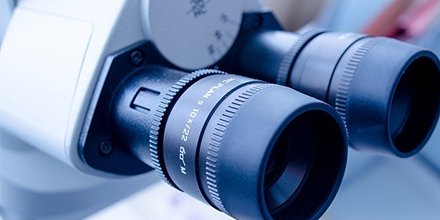Magnification is the enlargement of a specimen or an object seen through a microscope. It is a function performed solely by two parts of a microscope i.e. the eye piece (ocular) lenses and the objective lenses. The final image of a specimen under a microscope is seen by the ocular lens after being received from the objective lens that first magnifies the image to produce the true image. The total magnification of an image is therefore mathematically expressed as follows:
Magnification (m) = magnification of the objective lens X magnification of the eye piece lens.
The magnification of a microscope can be increased without limitation because it is not dependent on physical properties of light waves, but this is not the case for resolving power which is highly dependent on the type of light used. Therefore what the image of an object or specimen seen by a microscopist through a microscope is determined by the resolution and not the magnification of the microscope.
Microscopes are fitted with an artificial source of light (usually from a tungsten lamp) in order to ensure proper magnification and resolution of images through effective illumination since the illumination from daylight cannot be controlled. A microscope is normally fitted with about 3 or 4 objective lenses having magnifying power that includes: 4x, 10x, 40x and 100x. Higher magnifications of a specimen’s image are usually possible with sophisticated microscopes such as the transmission electron microscopes that provide enough resolution for very high magnifications (usually above 100,000x).
The light microscopes and other compound microscopes are usually limited in terms of their magnification as they have an upper limit of magnification (which is usually in the range of 1500x) beyond which an image becomes blurred or unclear. The resolution of the objective lens does not improve above this upper limit of magnification of the bright field microscopes; instead the image becomes more and more distorted.
During viewing under the microscope, the objective lenses can be switched or changed from one magnifying power to another (e.g. from 10x to 40x) and, the image of the object or specimen is expected to still remain in focus while this is being done. This property of the microscope is known as parfocality (i.e. the microscope is said to be parfocal).
It should be noted that the resolution and magnification of a microscope are normally imprinted on the body of the microscope. The distance between the front surface of an objective lens and the surface of the specimen (when the objective lens is in sharp focus) or the surface of the cover glass (if used) is known as the working distance of the microscope’s objective lens.
REFERENCES
Beck R.W (2000). A chronology of microbiology in historical context. Washington, D.C.: ASM Press.
Cheesbrough, M (2006). District Laboratory Practice in Tropical countries Part I Cambridge
Chung K.T, Stevens Jr., S.E and Ferris D.H (1995). A chronology of events and pioneers of microbiology. SIM News, 45(1):3–13.
Dictionary of Microbiology and Molecular Biology, 3rd Edition. Paul Singleton and Diana Sainsbury. 2006, John Wiley & Sons Ltd. Canada.
Glick B.R and Pasternak J.J (2003). Molecular Biotechnology: Principles and Applications of Recombinant DNA. ASM Press, Washington DC, USA.
Goldman E and Green L.H (2008). Practical Handbook of Microbiology, Second Edition. CRC Press, Taylor and Francis Group, USA.
Madigan M.T., Martinko J.M., Dunlap P.V and Clark D.P (2009). Brock Biology of microorganisms. 12th edition. Pearson Benjamin Cummings Publishers. USA.
Nester E.W, Anderson D.G, Roberts C.E and Nester M.T (2009). Microbiology: A Human Perspective. Sixth edition. McGraw-Hill Companies, Inc, New York, USA.
Prescott L.M., Harley J.P and Klein D.A (2005). Microbiology. 6th ed. McGraw Hill Publishers, USA.
Willey J.M, Sherwood L.M and Woolverton C.J (2008). Harley and Klein’s Microbiology. 7th ed. McGraw-Hill Higher Education, USA.
Discover more from #1 Microbiology Resource Hub
Subscribe to get the latest posts to your email.



